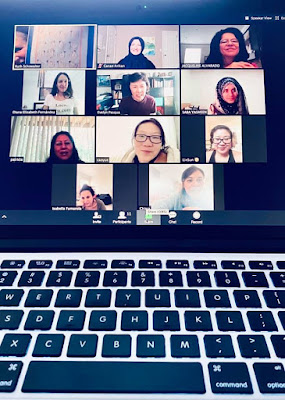Classroom Teachers, Why Do InterPlay?
I can tell you why I use InterPlay in my classroom as an instructor of English as a Second Language at the Georgia Tech Language Institute and a Certified
InterPlay Leader!
First of all, InterPlay is an active, creative way to
unlock the wisdom of the body. It is a thirty-year-old improvisational system
that uses movement, storytelling, voice and shape and stillness, to support
authenticity and foster ease and joy. Among the many reasons that InterPlay
co-founders Cynthia
Winton-Henry and Phil Porter, developed it was to be a tool for building
communities and social change.
Why not begin social
change in the classroom by building community? Change begins with the
individual. What if individual students were enlivened and supported to be more
themselves in a classroom of fully awakened and engaged citizen classmates?
InterPlay can facilitate
this transformation! To name a few things InterPlay does when used in the
classroom:
InterPlay...
-taps students’
creativity.
-implements students’
personal material.
-requires a different
level of student investment which can be powerful and playful.
-involves students in the
creative process which is stimulating and health promoting.
-allows students to respond
to information immediately (current issues, interests, and concerns) and relay
it in a personal way to listeners.
-impacts students’ lives
beyond the classroom (builds confidence and personal sense of power, provides
skills to deal with the unexpected, assists in the discovery of personal
strengths, relieves stress and promotes laughter, and teaches them to work with
others).
It would take a book to
address this question of why do InterPlay in the classroom. For now, I will
stop with an explanation of this improvisational system has been foundational
in what are now my four key concepts of instructional methodology:
Concept #1 EXPERIENTIAL. I know that students learn from doing, so I
transform my classroom into a community of people connecting and making
meaningful friendships, using improvisational forms and principles. While
students are engaging in activities of “doing and being,” they expand their
abilities to communicate effectively while deepening their connection to
themselves and to others.
Concept #2 KINESTHETIC. Movement engages students in experiencing a fuller sense of themselves. After more than two decades of teaching students ensconced in their desks, I had an epiphany! I needed to involve the “whole” person – not just the mind – but the body and heart as well. Freeing them from their seated positions, encumbered by books, pens, papers, jackets, backpacks, I invited my students to experiment with expanding their range of movement beyond their desks. I encourage them to find ways to use their physicality to express themselves in ways they find satisfying and successfully communicates their intentions.
Concept #3 NONJUDGMENTAL. Yes! I encourage students to take risks and make mistakes during our improvisational activities because doing so involves them in a process that leads to discovery, self-knowledge, and success. Critiques of “good and bad” are banished in order to achieve an environment for exploration and risk taking. Instead, we are searching for choices through a range of experiences and unknowing.
Concept #4 REFLECTIVE. Quiet
moments of reflection are important after kinesthetic activities, engagement
with others, and jumping into the unknown. When students stop and “notice” how
feel physically and emotionally and what they are thinking, something
powerful takes place – self-discovery, connection to others and development of
“new” knowledge. When these reflections are shared with classmates, it
allows students to connect in a different and perhaps deeper way than discussing
just the content provided by the activities.








Comments
Post a Comment